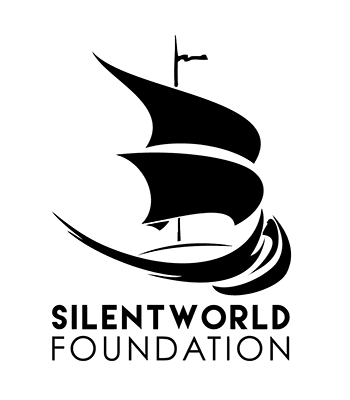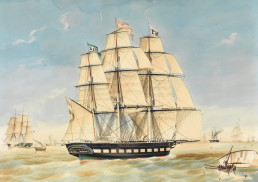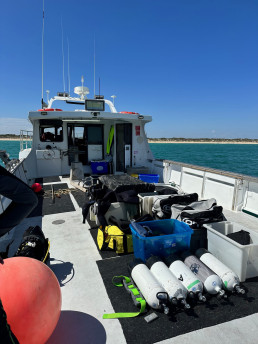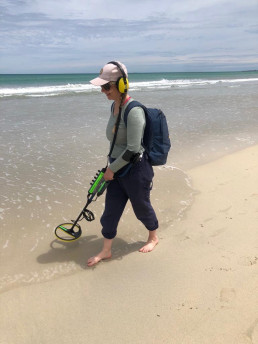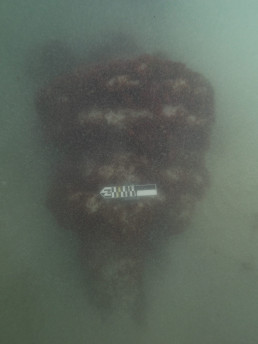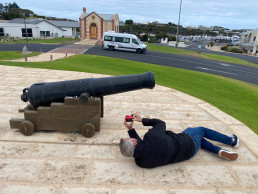Koning Willem
A Brief History
Koning Willem de Tweede, an 800-ton Dutch merchant sailing ship, was lost on 30th June 1857, in Guichen Bay near Robe, South Australia. The ship was transporting Chinese miners to the port of Robe, where they would begin their overland journey to the goldfields in Victoria. Silentworld Foundation and Australian National Maritime Museum began investigations into the whereabouts of the wreck in April of 2022.
In addition to the on- and in-water surveys with magnetometer and metal detectors, we have conducted community conservation workshops and investigated shipwreck artefacts that are held within the community.
In March of 2025, in conjunction with Australian National Maritime Museum, Flinders University, and Department for Environment and Water, we have most likely identified the wreck of Koning Willem de Tweede.
Wrecking Event
Koning Willem de Tweede was transporting Chinese miners to the port of Robe, where they would begin an overland journey to the goldfields. Luckily, all 400 Chinese passengers had offloaded from the ship on the 15th of June, while the ship remained anchored in Guichen Bay while waiting out inclement weather. However, on the 30th June a severe storm struck. Reports vary as to whether or not the windlass was wrenched from the deck, but eventually Captain Hindrik Remmelt Giezen ordered the ship to run aground on Long Beach. The ship grounded on sand close in to shore, but perhaps due to the storm’s intensity and wave action, it broke up very quickly. In total 15 of the crew of 25 were lost as a lifeboat tipped over. Captain Giezen did survive the event, and was eventually rescued by way of a barrel tied to a rope, the other end of which was thrown to rescuers on shore who towed him through the surf.
Archaeological Surveys
Accounts from 1857 state that the ship wrecked four miles from the town’s centre at Long Beach. The research team drew a straight line from the Customs House at Robe, finding the point four miles along and used this as the basis of the search area.
Two attempts were made to find the wreck using divers, metal detectors and a magnetometer, before the third and ultimately successful attempt. On shore surveys were also undertaken using metal detectors.
In March of 2025, Silentworld Foundation’s Heather Berry and Australian National Maritime Museum’s Dr James Hunter teamed up with Mark Polzer from Department of Environment and Water, Ruud Stelten and Justine Buchler from Flinders University, and Kevin Jones, formerly Director of the South Australian Maritime Museum, to search for the shipwreck.
A magnetometer operated by Justine Buchler was towed behind the boat, and she identified points of interest as indicated by the instrument. Once these points were noted, the team returned to the most promising looking point and dived. James Hunter, Mark Polzer, and Ruud Stelten dived the promising magnetometer hit and immediately found a large iron object proud of the seabed, which Ruud Stelten photographed. The poor visibility underwater and at times intense surge made the site difficult to explore and map, but further examination was required.
Subsequent dives involved further investigation of the object of interest, which appears to be a windlass. While assisting James Hunter with measurements of the object so that it could be drawn topside, Heather Berry caught a glimpse of a timber, only just visible through the sand. Probing of the area seemed to reveal that there was perhaps more timber under the surface of the sand.
After three days of diving the probable windlass had been photographed and measured thoroughly, and visibility and surge conditions made it unwise to continue diving activities.
Based on the location of the windlass which was proud of the seabed, and the pattern of anomalies detected by the magnetometer, the team is confident in the declaration that this is the site of the wreck of Koning Willem de Tweede.
Robe Community Events
Beginning in 2022, the team from Silentworld Foundation and Australian National Maritime Museum have not only been actively involved with searching for Koning Willem de Tweede, but also engaging with the community members, many of whom have found shipwreck materials washed up on shore. These may be from Koning Willem de Tweede, but may also be from several other ships known to have wrecked in Guichen Bay. The examination of these artefacts, and recommendations made by Silentworld Foundation’s conservator Heather Berry, inspired a conservation booklet aimed at communities (LINK HERE).
Community conservation workshops
In total, three community workshops have been held, hosted at the Customs House operated by the National Trust of South Australia Robe Branch.
While James Hunter was able to assist community members who brought in sherds of ceramics, pieces of timber, and iron concretions with identification of their objects, Heather Berry was able to provide some first aid conservation and storage recommendations.
Community events
Although many in Robe are very familiar with Koning Willem de Tweede’s story, it was always important to the team to keep the community updated with what they were doing. Therefore, most visits to Robe included community information nights, where all were welcome to come along, refresh themselves on the story of the wrecking of Koning Willem de Tweede, and hear about what the team was discovering (or not) under the waves and in the archives.
These events were generously hosted by National Trust of South Australia Robe branch in conjunction with the Robe History Group, and the audiences sometimes included descendants of the surviving crew, always making for lively discussions and even family reunions.
The Koning Willem de Tweede Shipwreck Project has been assisted by the Dutch Ministry of Foreign Affairs, through the Embassy of Kingdom of the Netherlands, Australia and the Cultural Heritage Agency of the Netherlands.
